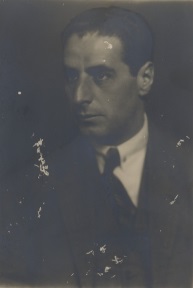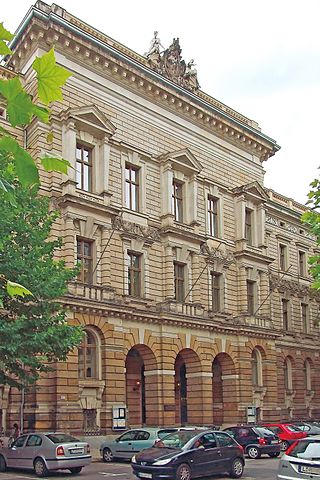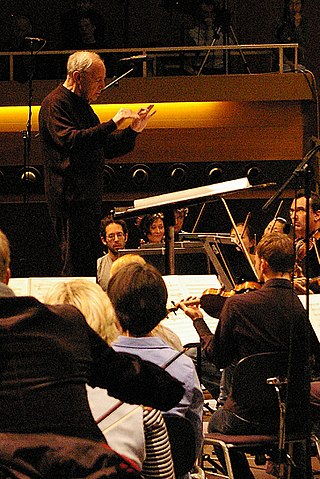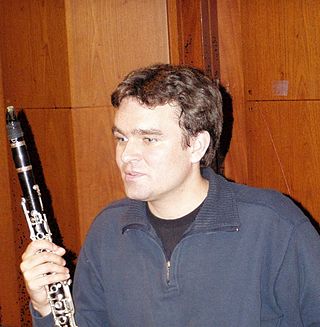Related Research Articles

Carl Heinrich Maria Orff was a German composer and music educator, who composed the cantata Carmina Burana (1937). The concepts of his Schulwerk were influential for children's music education.

In music, the BACH motif is the motif, a succession of notes important or characteristic to a piece, B flat, A, C, B natural. In German musical nomenclature, in which the note B natural is named H and the B flat named B, it forms Johann Sebastian Bach's family name. One of the most frequently occurring examples of a musical cryptogram, the motif has been used by countless composers, especially after the Bach Revival in the first half of the 19th century.

Luigi Nono was an Italian avant-garde composer of classical music.
The original Tristan chord is heard in the opening phrase of Richard Wagner's opera Tristan und Isolde as part of the leitmotif relating to Tristan. It is made up of the notes F, B, D♯, and G♯:

Ernst Toch was an Austrian composer of European classical music and film scores, who from 1933 worked as an émigré in Paris, London and New York. He sought throughout his life to introduce new approaches to music.

Hans Werner Henze was a German composer. His large oeuvre is extremely varied in style, having been influenced by serialism, atonality, Stravinsky, Italian music, Arabic music and jazz, as well as traditional schools of German composition. In particular, his stage works reflect "his consistent cultivation of music for the theatre throughout his life".

Johann Adam Hiller was a German composer, conductor and writer on music, regarded as the creator of the Singspiel, an early form of German opera. In many of these operas he collaborated with the poet Christian Felix Weiße.

The University of Music and Theatre "Felix Mendelssohn Bartholdy" Leipzig (German: Hochschule für Musik und Theater "Felix Mendelssohn Bartholdy" Leipzig) is a public university in Leipzig (Saxony, Germany). Founded in 1843 by Felix Mendelssohn as the Conservatorium der Musik (Conservatory of Music), it is the oldest university school of music in Germany.

Darmstadt School refers to a group of composers who were associated with the Darmstadt International Summer Courses for New Music from the early 1950s to the early 1960s in Darmstadt, Germany, and who shared some aesthetic attitudes. Initially, this included only Pierre Boulez, Bruno Maderna, Luigi Nono, and Karlheinz Stockhausen, but others came to be added, in various ways. The term does not refer to an educational institution.

Ernst Pepping was a German composer of classical music and academic teacher. He is regarded as an important composer of Protestant sacred music in the 20th century.
York Höller is a German composer and professor of composition at the Hochschule für Musik Köln.

The Donaueschinger Festival is a festival for new music that takes place every October in the small town of Donaueschinger in south-western Germany. Founded in 1921, it is considered the oldest festival for contemporary classical music in the world, and among the best-known and most prestigious.
Volker David Kirchner was a German composer and violist. After studies of violin and composition at the Peter Cornelius Conservatory, the Hochschule für Musik Köln and the Hochschule für Musik Detmold, he worked for decades as a violist in the Radio-Sinfonie-Orchester Frankfurt. He was simultaneously the violist in the Kehr Trio founded by his violin teacher Günter Kehr, and a composer of incidental music at the Hessisches Staatstheater Wiesbaden.

Violeta Dinescu is a Romanian composer, pianist and academic teacher, living in Germany since 1982.

Jörg Widmann is a German composer, conductor and clarinetist. In 2018, Widmann was the third most performed contemporary composer in the world. Formerly a clarinet and composition professor at the University of Music Freiburg, he is composition professor at the Barenboim–Said Akademie. His most important compositions are the two operas Babylon and Das Gesicht im Spiegel, an oratorio Arche, Kantate and the concert overture Con brio. Widmann has written musical tributes to Classical and Romantic composers. He was awarded the Bavarian Maximilian Order for Science and Art in 2018 and the Bach Prize of the Free and Hanseatic City of Hamburg in 2023.

Fritz Graßhoff was a German painter, poet and songwriter. He was known for hits sung by Lale Andersen, Freddy Quinn and Hans Albers. As a painter, he participated in important exhibitions; as a writer, he was known for his lyric volume Halunkenpostille and his autobiographical novel Der blaue Heinrich. He translated poetry by the Ancient Roman Martial and the Swede Carl Michael Bellman. Many of his writings have been set to music by composers such as James Last, Norbert Schultze and Siegfried Strohbach.

Graham Waterhouse, cellist and composer especially of chamber music, has written a number of song cycles. As a cellist, he has used string instruments or a Pierrot ensemble instead of the typical piano to accompany a singer. In 2003 he composed a first cycle of songs based on late poems by Friedrich Hölderlin. In 2016, he set nursery rhymes, excerpts from James Joyce, and texts by Shakespeare. In 2017, he wrote settings of poems by Irish female writers, and in 2022 a cycle of Buddhist texts for mezzo-soprano, cello and piano.
Walter Courvoisier was a Swiss composer.
Volker Straebel is a German musicologist and composer and performer of experimental music.

Manos Tsangaris is a German composer, musician, sound art installation and performance artist, and a poet.
References
- Lawrence Weschler, Popocatepetl: A Noodling Reminiscence, The Threepenny Review —memories from the composer's grandson
- Diana Castelnuovo-Tedesco, Toch's Spoken Music Rediscovered